Ciudad Bolivar to Canaima Camp
22. May: Our plane is scheduled to leave Ciudad Bolivar at 8:00 so we're at the airport at 7:00.
We check in and then go outside the airport to take a look at Jimmy Angel's plane. This
was the actual plane which he had borrowed and in which he crash-landed on Auyan Tepui.
Actually, his wheels bogged down in the soft mud and he was unable to take off again. He
and his party had to climb down the near-vertical cliffs of the Tepui and it took them 10
days to reach civilization. The plane remained on the Tepui till the 1970's, when it was
transported to Ciudad Bolivar and restored by the Venezuelan Air Force. It's actually
possible to open the doors of the pilot, passenger and luggage cabins and peer in. The
doors are made of amazingly light aluminium. The plane is in good shape, although it is
outdoors, totally unprotected from the elements.
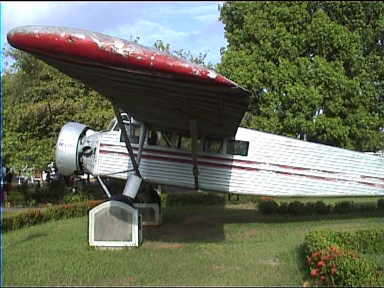 |
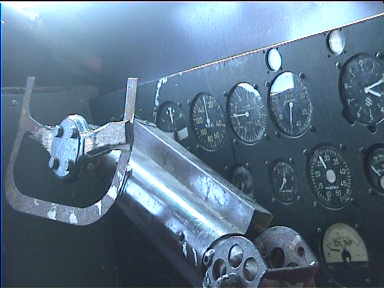 |
 Jimmy Angel's actual plane in which he "discovered" the Angel
Falls and crash-landed on Auyan Tepui is on display outside Ciudad Bolivar airport. It was
recovered and restored in the 70's by the Venezuelan Air Force Jimmy Angel's actual plane in which he "discovered" the Angel
Falls and crash-landed on Auyan Tepui is on display outside Ciudad Bolivar airport. It was
recovered and restored in the 70's by the Venezuelan Air Force
|
 Inside
Jimmy Angel's plane Inside
Jimmy Angel's plane
|
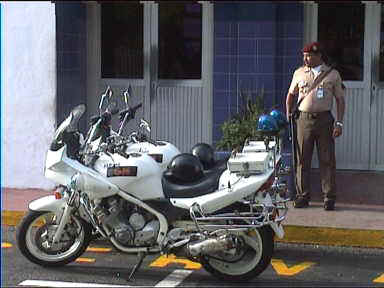 |
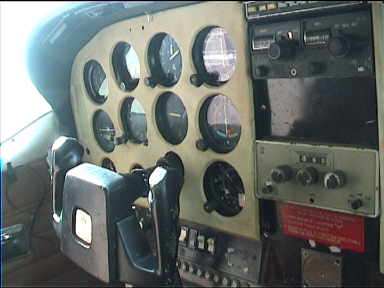 |
 Police
guy posing outside Ciudad Bolivar airport Police
guy posing outside Ciudad Bolivar airport
|
 The
controls of our plane taking us to Canaima: I got to sit in the seat right next to the
pilot The
controls of our plane taking us to Canaima: I got to sit in the seat right next to the
pilot
|
No breakfast was included with the hotel, so we have two muffins and coffee at one of
the airport cafes. We then go to the plane, a Cessna 172 5-seater (Thanks for the correction, Thomas), I get to sit right next to
the pilot! There are two other passengers along with us so we are 5 in total including the
pilot. There are some clouds on the way and since the plane is flying at visibility, the
pilot has to avoid them by either flying above or to the side of them. The landscape below
is mostly flat, sometimes seeing a meandering river. Seeing Canaima for the first time is
wonderful, we suddenly see the Tepuis and Canaima Falls and Canaima Lagoon!
The landing is smooth enough and when we enter 'Canaima Airport' (a shed or two), we
are greeted by a representative of 'Tiuna Tours', our tour operator. We are free to check
out the lagoon till 11:45 (it's about 9:30 now).
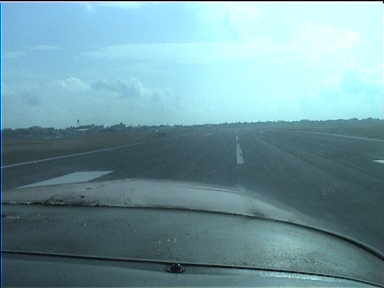 |
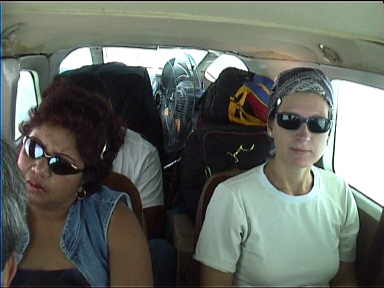 |
 Taking
off from Ciudad Bolivar Taking
off from Ciudad Bolivar
|
 A
view of the rest of the plane.. A
view of the rest of the plane..
|
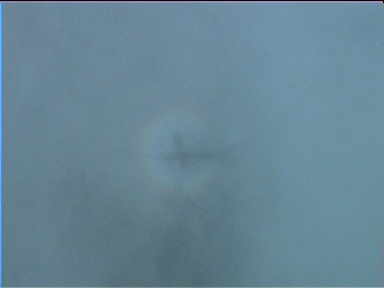 |
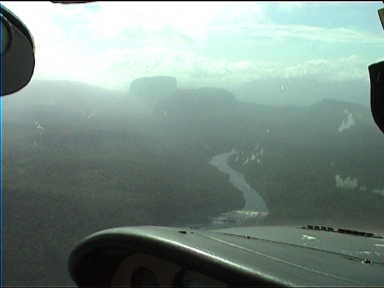 |
 Look
at the halo of the plane on the clouds Look
at the halo of the plane on the clouds
|
 First
view of magnificent Canaima with Tepuis in the background!! First
view of magnificent Canaima with Tepuis in the background!!
|
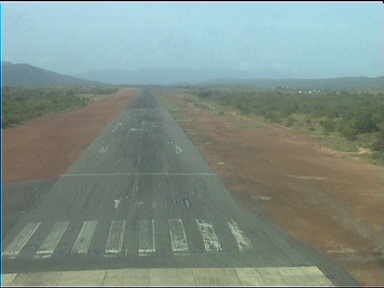 |
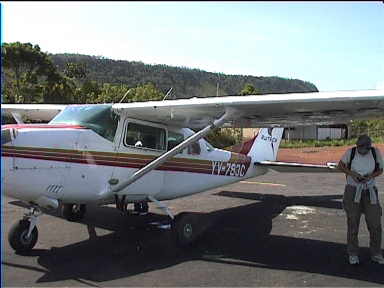 |
 Landing
at Canaima Landing
at Canaima
|
 Our
plane's just landed at Canaima Our
plane's just landed at Canaima
|
The lagoon itself has deep red water, apparently a vegetable colouring, although I
could well imagine it to be reddish Tepui sand. The banks of the lagoon are surprisingly
shallow for very far into the water. We see a local woman on a sandbank busy washing her
clothes in the lagoon. We walk along the banks of the river till we reach the electrical
generator station which is to the right of and near to the falls themselves. A massive
current of water exits it and flows into the lagoon and you can hear the churning of the
turbines. A bit further on the path stops but it is possible to walk on till Canaima
Falls. It is fascinating to hear the roar of the water, whose volume is constantly
increasing as I approach the falls. At the first waterfall, I discover that there is a
space underneath it and I can't resist taking off my T-shirt and creeping into that space.
I know that I must be very careful, because any misstep could cause me to slip and plunge
into the mix of a thundering waterfall and lots of rocks below, probably being the end of
me!
Small step by small step I slowly walk into the space behind the waterfall and the
sensation of being there is absolutely overwhelming!! The thunderous sound of water
completely envelops me, the optical rush of seeing this massive flow of water just within
grasp in front of me is stunning! What an experience. Later, we learn that this part of
Canaima Falls is called 'Hell' by the natives. Well, I actually was in Hell and lived to
tell the tale!
We're back at the airport at 11:45, we meet our guide Alexander, and we take a pickup
to the 'Tiuna Camp' to have lunch. We get the chance to meet the other people who would
accompany us to Angel Falls. There are two young German couples and a stocky Swiss couple
with us. Our guide is supposed to speak English, but he switches to German by popular
demand. Lunch is chicken with rice and ice-tea, with some watermelon as dessert. It was
quite good.
The guide then takes us to the roof of the building to get a better view of the
surroundings. There we see Canaima Falls and the Tepuis. It turns out that there will be
no electricity while we are on the way to Angel Falls, so I won't be able to charge the
battery of my Video-Cam, so I must economize. I manage to get a last charge in the
electrical outlet in the room of our guide, and after that I would have to make do till we
were back in Ciudad Bolivar. The guide told me right then to "save my battery for
Angel Falls". I was very frugal and indeed managed to make do with that single
charge.
We have to pack our entire luggage in plastic bags for the trip, big black bags for
backpacks and large luggage and small bright orange bags for hand-equipment is distributed
along with some string to tie the tops together. Then we get into our 'Curiara', which is
an extremely long and thin boat. I was wondering why the boats were constructed like this
and it was only later that I realized it. They were perfect to maneuver upstream in an
extremely shallow river, and could also be made to leap up small mini-waterfalls in the
river (although without any passengers on board, they would have to walk along the river).
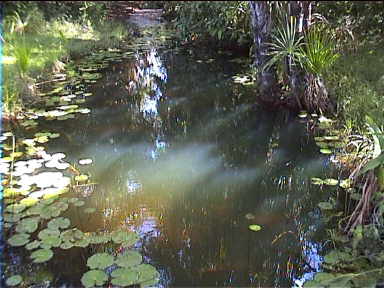 |
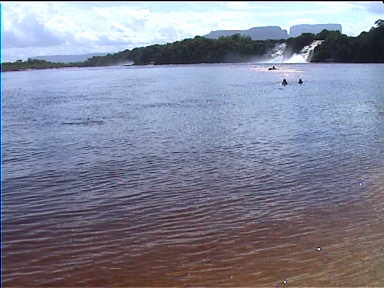 |
 Quiet
waterspot at Canaima Quiet
waterspot at Canaima
|
 Canaima
Lagoon with reddish water and Canaima Falls and Tepuis in the background. What an amazing
landscape! Canaima
Lagoon with reddish water and Canaima Falls and Tepuis in the background. What an amazing
landscape!
|
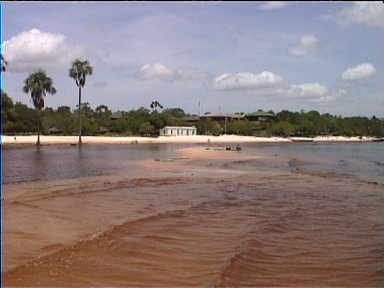 |
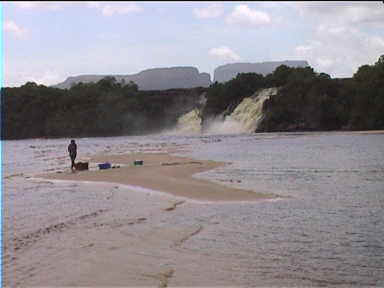 |
 Canaima
Lagoon with reddish water Canaima
Lagoon with reddish water
|
 Canaima
Lagoon with Canaima Falls Canaima
Lagoon with Canaima Falls
|
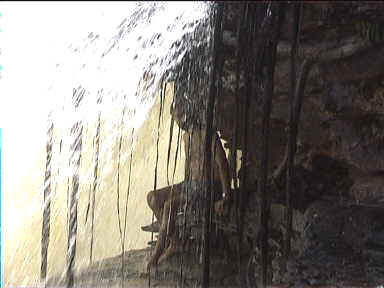 |
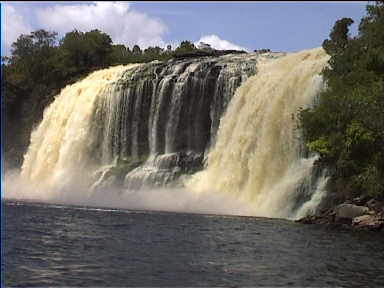 |
 I discovered that it was possible to sit under these falls termed "Hell" at Canaima
Falls. What a amazing, thundering experience!! I discovered that it was possible to sit under these falls termed "Hell" at Canaima
Falls. What a amazing, thundering experience!!
|
 The
massive main Canaima Falls in dry season! The
massive main Canaima Falls in dry season!
|
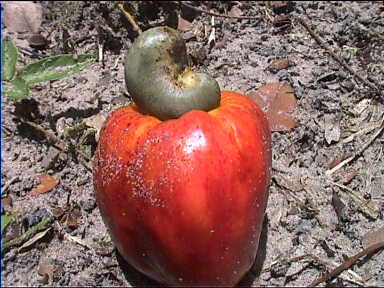 |
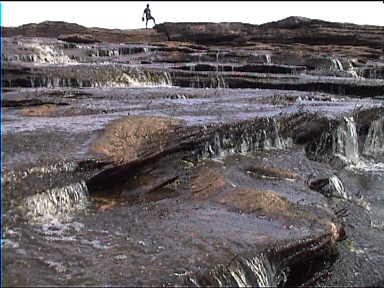 |
 One
Cashew nut. No wonder they are so expensive! One
Cashew nut. No wonder they are so expensive!
|
 Sapito
falls (dry season, hardly water!) Sapito
falls (dry season, hardly water!)
|
We set off, first to sail past the Canaima Falls, the one on the left is the largest,
called 'Salto Hacha'. I was too scared about big water splashes on my camera to film it. I
knew that small amounts of water were enough to completely destroy the fickle electronics
of Video-Cams and I was in no mood to take any chances. Then we reach Anatoly's Island and
we hike through some vegetation to reach the Sapo Falls. It is dry season and there is
little water and it's possible to walk in the area which normally would be the top of a
thundering waterfall! Wonderful rock structures and plants can be seen. From the top there
is a good view of the surrounding landscape, especially some marvelous Tepuis! I can't
get enough of them! We walk on to a small lagoon of water where we can have a swim in the
reddish water.
We continue to the next attraction, the Sapito Falls. It is possible to walk along a
path under them. Our guide packs all our hand equipment (the rest is still on the boat
under a thick sheet of plastic) in plastic sacks and carries it through the wet part of
the path. We all wear some swimming gear, since we are to get wet. It must be a great
experience to walk the path in the rainy season with a lot of water, now it is less than
spectacular. We continue on along a path till we reach a spot where we are picked up by
our boat.
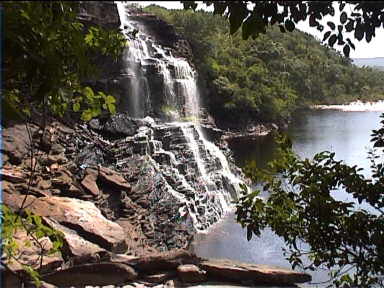 |
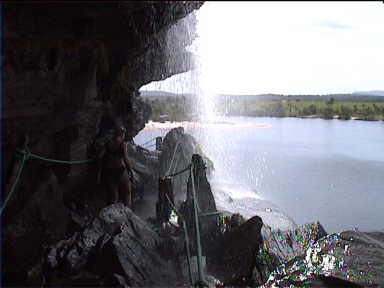 |
 Sapo
Falls in dry season Sapo
Falls in dry season
|
 You
can actually walk under Sapo Falls (dry season, no water!) You
can actually walk under Sapo Falls (dry season, no water!)
|
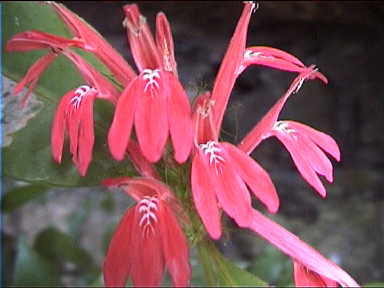 |
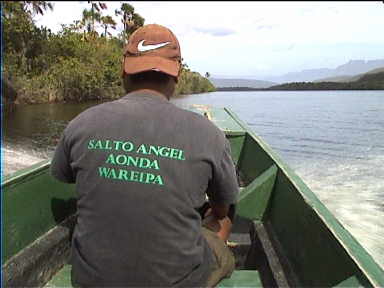 |
 Look
at this exotic flower! Look
at this exotic flower!
|
 OK,
now we start of in the direction of Angel Falls (although we will not reach today). The
guy in front of us is our guide OK,
now we start of in the direction of Angel Falls (although we will not reach today). The
guy in front of us is our guide
|
We race along the water for quite awhile, we sit two abreast in the narrow boat, close
to each other to avoid falling out. The water splashes on the outside due to our speed.
Our guide has the front seat and the boat's captain is at the back, steering the powerful
outboard motor. As soon as the water gets shallow, speed is immediately reduced. The ride
is awesome, being amidst the unique Tepui Landscape which keeps changing around us as we
proceed. We stop at Mayupa Peninsula and walk across it. Our guide shows us the mango
trees there. It is possible to eat these seemingly unripe mangoes right through their
skin! I've never seen this before. Nearby there is an amazing bright green lizard which is
so still and unnatural that it looks like a plastic toy. I'm able to near it to almost
touching distance, and although I sense that it is very nervous about me being so close,
chooses not to move at all! Walking along sometime later, I notice that my legs are
covered with about 10 sand fleas (puri puri) sucking my blood! I remove them one by one,
some of them leave a blood stain on my leg. Annewien has a similar problem. We need to
remove them a couple of times more as we proceed on our walk on the peninsula.
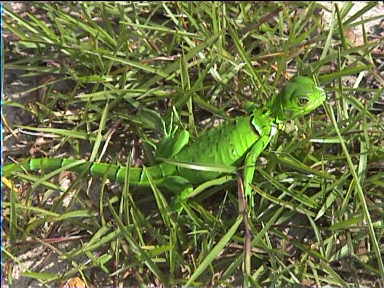 |
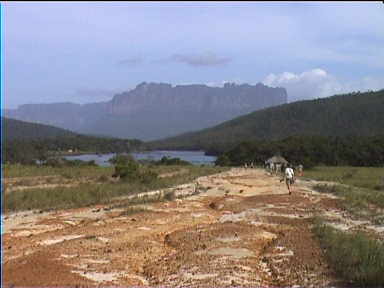 |
 A
'plastic' lizard A
'plastic' lizard
|
 Wonderful
walk on Mayupa Peninsula overlooking river and Tepuis Wonderful
walk on Mayupa Peninsula overlooking river and Tepuis
|
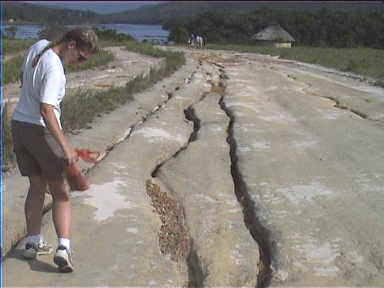 |
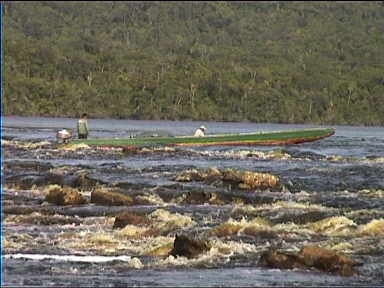 |
 There
were some bad sand fleas here on Mayupa Peninsula. We got lots of bloody bites on our legs There
were some bad sand fleas here on Mayupa Peninsula. We got lots of bloody bites on our legs
|
 Our
long boat frequently needed to climb the river rapids on it's own with everyone walking on
the river bank Our
long boat frequently needed to climb the river rapids on it's own with everyone walking on
the river bank
|
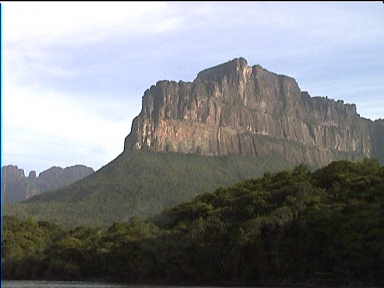 |
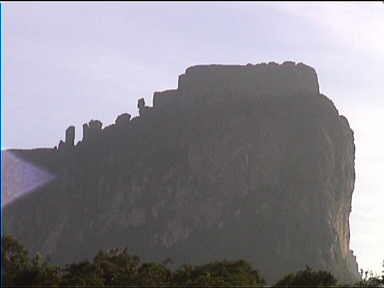 |
 Majestic
Tepui, looking somewhat like an American locomotive Majestic
Tepui, looking somewhat like an American locomotive
|
 Tepui
with high piles of rock looking unreal Tepui
with high piles of rock looking unreal
|
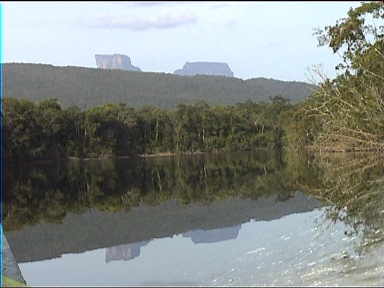 |
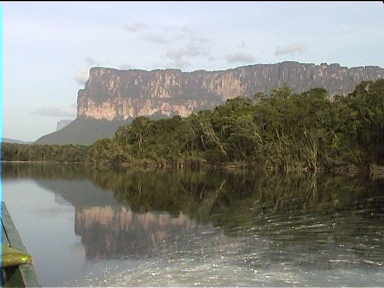 |
 Tepuis
in the distance reflect in the water. Water splashing on the right is from our boat Tepuis
in the distance reflect in the water. Water splashing on the right is from our boat
|
 Auyan
Tepui, the largest one of all and home of Angel Falls Auyan
Tepui, the largest one of all and home of Angel Falls
|
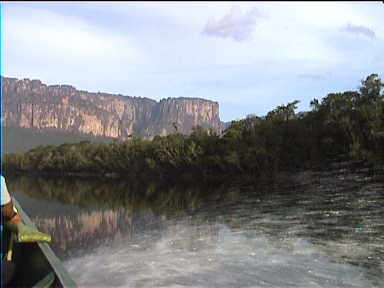 |
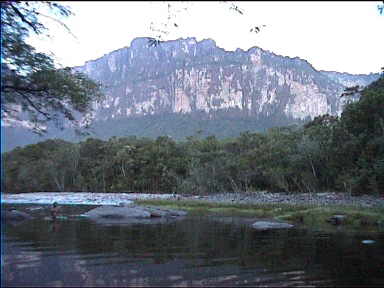 |
 Tepui
and splashes of furious boat ride Tepui
and splashes of furious boat ride
|
 Our
Base-Camp for two nights. We can bathe here (if you look carefully, you'll see a bather) Our
Base-Camp for two nights. We can bathe here (if you look carefully, you'll see a bather)
|
Back on our boat, we ride past 'Orchid Island' to our camp for the night (on the Ahouda
river). The camp consists of a large shed with a corrugated-iron roof, under which all the
hammocks are already strung from thick wooden beams. There is a toilet area in the shed
and kitchen and meals areas. There is a petrol lamp high up giving a bit of light, and of
course, no electricity. The floor is dusty and there is a faint stable-smell in the air.
There are two dogs sitting around, one cat with an infections would, some poultry, and
there is a cardboard box near the kitchen containing two turtles with many fruit flies
flying around them.
We have dinner, after which Alexander offers small sips of Anis liquor. It's lucky that
we have our flashlights, they are mandatory to find the way in the dark to the toilets! We
retire to our hammocks at about 20:00, and I sleep surprisingly well in mine. It is
necessary to sleep diagonally in a hammock, in order to keep the spine straight! The night
is a bit chilly and I need to distribute my blanket both over and under me, to avoid cold
air reaching me from below.
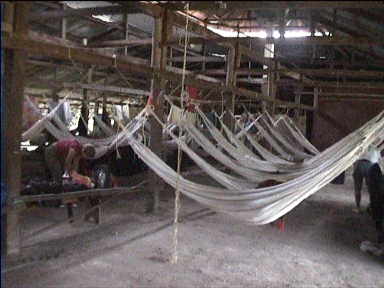 |
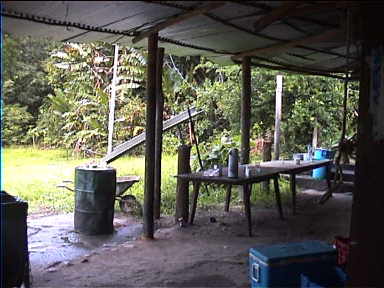 |
 We
sleep in Hammocks for two nights in this shed with a corrugated roof and a dust floor We
sleep in Hammocks for two nights in this shed with a corrugated roof and a dust floor
|
 Camp
is extremely rudimentary. To bathe, "use the river". You can see the contraption
to collect rain water in a barrel. On the right is the 'coffee table'. There are no walls
and hence no doors. Camp
is extremely rudimentary. To bathe, "use the river". You can see the contraption
to collect rain water in a barrel. On the right is the 'coffee table'. There are no walls
and hence no doors.
|


































